Samsung's Competitive Strategies and Global Market Analysis Report
VerifiedAdded on 2021/12/28
|9
|1903
|26
Report
AI Summary
This report examines Samsung's competitive strategies in the global market, focusing on Porter's Five Forces analysis to assess the company's position. The report analyzes factors such as supplier bargaining power, customer bargaining power, the threat of new entrants, the threat of substitutes, and competitive rivalry within the electronics industry. The analysis reveals Samsung's strengths and weaknesses in each area. The report then proposes four key strategies for Samsung to enhance its competitive advantage: manufacturing its own hardware to reduce costs, fostering innovation in its products, adopting a transitional strategy to differentiate itself, and offering budget-friendly Android phones to expand its customer base. The conclusion summarizes the findings and emphasizes the importance of these strategies for Samsung's continued success in the global market.

Running Head: SAMSUNG 0
Samsung
Managing Complexity
Samsung
Managing Complexity
Paraphrase This Document
Need a fresh take? Get an instant paraphrase of this document with our AI Paraphraser

SAMSUNG 1
Contents
Introduction...........................................................................................................................................3
Four strategies that Samsung could adopt to gain competitive advantage globally...............................6
Conclusion.............................................................................................................................................7
References.............................................................................................................................................8
Contents
Introduction...........................................................................................................................................3
Four strategies that Samsung could adopt to gain competitive advantage globally...............................6
Conclusion.............................................................................................................................................7
References.............................................................................................................................................8
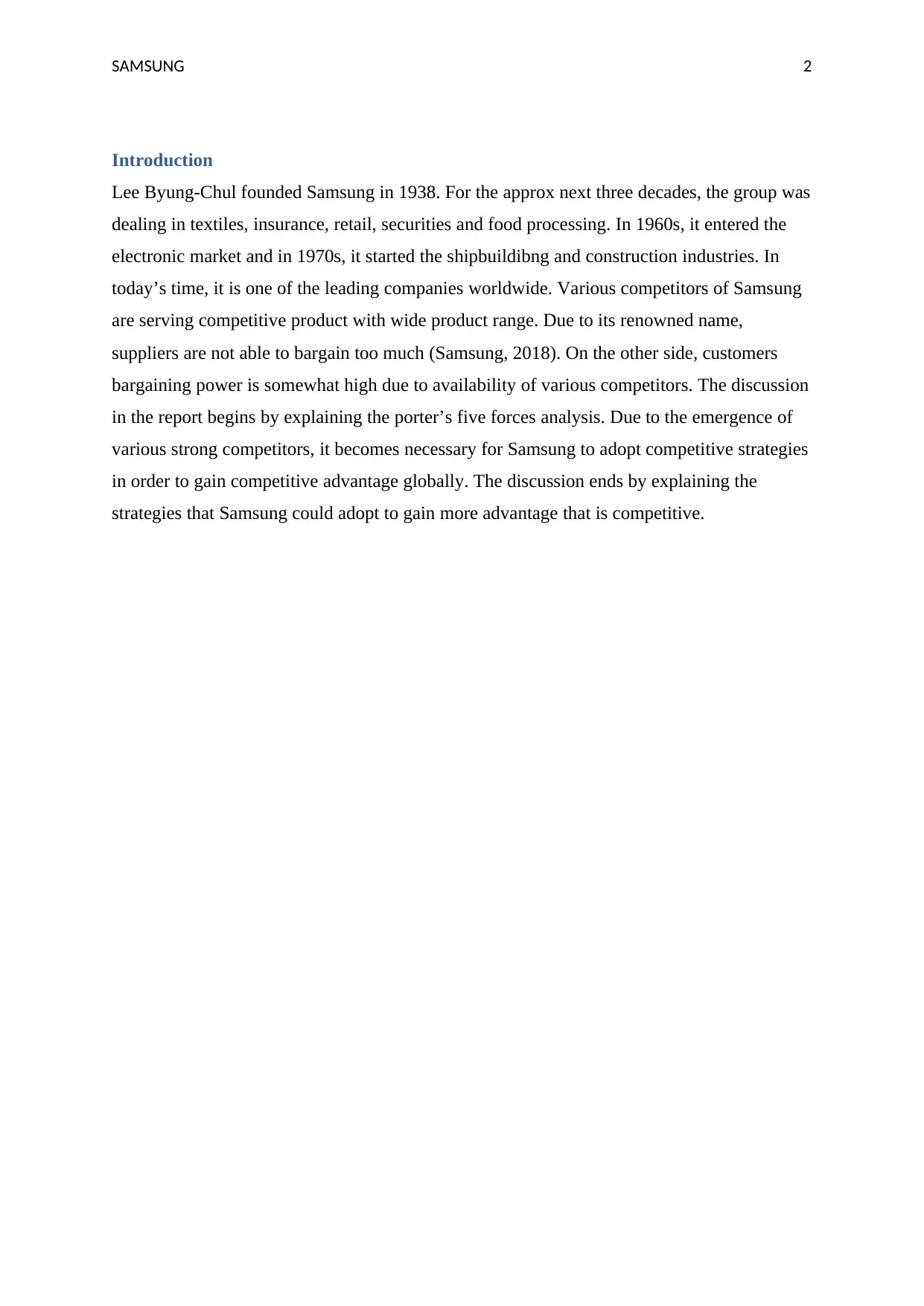
SAMSUNG 2
Introduction
Lee Byung-Chul founded Samsung in 1938. For the approx next three decades, the group was
dealing in textiles, insurance, retail, securities and food processing. In 1960s, it entered the
electronic market and in 1970s, it started the shipbuildibng and construction industries. In
today’s time, it is one of the leading companies worldwide. Various competitors of Samsung
are serving competitive product with wide product range. Due to its renowned name,
suppliers are not able to bargain too much (Samsung, 2018). On the other side, customers
bargaining power is somewhat high due to availability of various competitors. The discussion
in the report begins by explaining the porter’s five forces analysis. Due to the emergence of
various strong competitors, it becomes necessary for Samsung to adopt competitive strategies
in order to gain competitive advantage globally. The discussion ends by explaining the
strategies that Samsung could adopt to gain more advantage that is competitive.
Introduction
Lee Byung-Chul founded Samsung in 1938. For the approx next three decades, the group was
dealing in textiles, insurance, retail, securities and food processing. In 1960s, it entered the
electronic market and in 1970s, it started the shipbuildibng and construction industries. In
today’s time, it is one of the leading companies worldwide. Various competitors of Samsung
are serving competitive product with wide product range. Due to its renowned name,
suppliers are not able to bargain too much (Samsung, 2018). On the other side, customers
bargaining power is somewhat high due to availability of various competitors. The discussion
in the report begins by explaining the porter’s five forces analysis. Due to the emergence of
various strong competitors, it becomes necessary for Samsung to adopt competitive strategies
in order to gain competitive advantage globally. The discussion ends by explaining the
strategies that Samsung could adopt to gain more advantage that is competitive.
⊘ This is a preview!⊘
Do you want full access?
Subscribe today to unlock all pages.

Trusted by 1+ million students worldwide
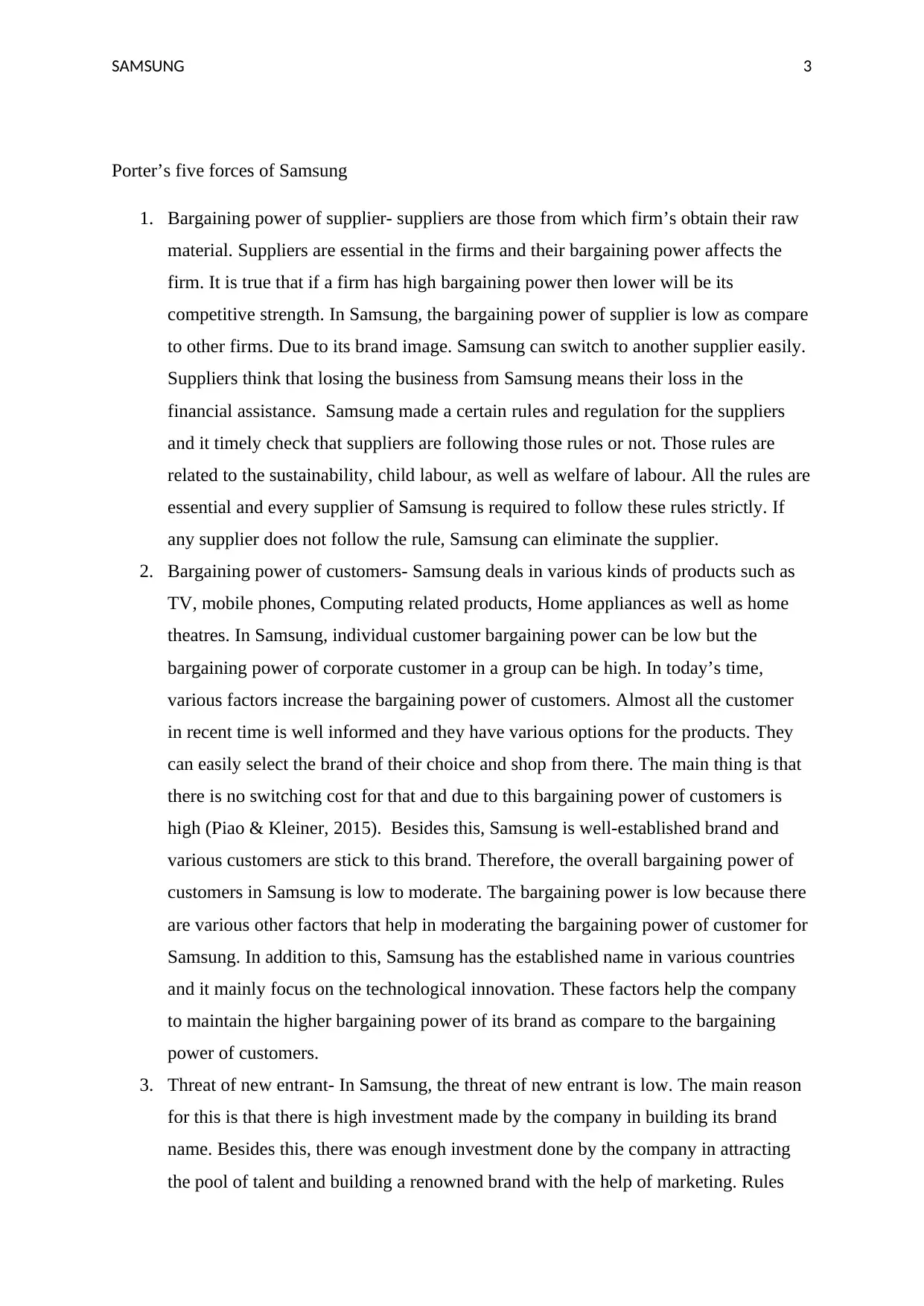
SAMSUNG 3
Porter’s five forces of Samsung
1. Bargaining power of supplier- suppliers are those from which firm’s obtain their raw
material. Suppliers are essential in the firms and their bargaining power affects the
firm. It is true that if a firm has high bargaining power then lower will be its
competitive strength. In Samsung, the bargaining power of supplier is low as compare
to other firms. Due to its brand image. Samsung can switch to another supplier easily.
Suppliers think that losing the business from Samsung means their loss in the
financial assistance. Samsung made a certain rules and regulation for the suppliers
and it timely check that suppliers are following those rules or not. Those rules are
related to the sustainability, child labour, as well as welfare of labour. All the rules are
essential and every supplier of Samsung is required to follow these rules strictly. If
any supplier does not follow the rule, Samsung can eliminate the supplier.
2. Bargaining power of customers- Samsung deals in various kinds of products such as
TV, mobile phones, Computing related products, Home appliances as well as home
theatres. In Samsung, individual customer bargaining power can be low but the
bargaining power of corporate customer in a group can be high. In today’s time,
various factors increase the bargaining power of customers. Almost all the customer
in recent time is well informed and they have various options for the products. They
can easily select the brand of their choice and shop from there. The main thing is that
there is no switching cost for that and due to this bargaining power of customers is
high (Piao & Kleiner, 2015). Besides this, Samsung is well-established brand and
various customers are stick to this brand. Therefore, the overall bargaining power of
customers in Samsung is low to moderate. The bargaining power is low because there
are various other factors that help in moderating the bargaining power of customer for
Samsung. In addition to this, Samsung has the established name in various countries
and it mainly focus on the technological innovation. These factors help the company
to maintain the higher bargaining power of its brand as compare to the bargaining
power of customers.
3. Threat of new entrant- In Samsung, the threat of new entrant is low. The main reason
for this is that there is high investment made by the company in building its brand
name. Besides this, there was enough investment done by the company in attracting
the pool of talent and building a renowned brand with the help of marketing. Rules
Porter’s five forces of Samsung
1. Bargaining power of supplier- suppliers are those from which firm’s obtain their raw
material. Suppliers are essential in the firms and their bargaining power affects the
firm. It is true that if a firm has high bargaining power then lower will be its
competitive strength. In Samsung, the bargaining power of supplier is low as compare
to other firms. Due to its brand image. Samsung can switch to another supplier easily.
Suppliers think that losing the business from Samsung means their loss in the
financial assistance. Samsung made a certain rules and regulation for the suppliers
and it timely check that suppliers are following those rules or not. Those rules are
related to the sustainability, child labour, as well as welfare of labour. All the rules are
essential and every supplier of Samsung is required to follow these rules strictly. If
any supplier does not follow the rule, Samsung can eliminate the supplier.
2. Bargaining power of customers- Samsung deals in various kinds of products such as
TV, mobile phones, Computing related products, Home appliances as well as home
theatres. In Samsung, individual customer bargaining power can be low but the
bargaining power of corporate customer in a group can be high. In today’s time,
various factors increase the bargaining power of customers. Almost all the customer
in recent time is well informed and they have various options for the products. They
can easily select the brand of their choice and shop from there. The main thing is that
there is no switching cost for that and due to this bargaining power of customers is
high (Piao & Kleiner, 2015). Besides this, Samsung is well-established brand and
various customers are stick to this brand. Therefore, the overall bargaining power of
customers in Samsung is low to moderate. The bargaining power is low because there
are various other factors that help in moderating the bargaining power of customer for
Samsung. In addition to this, Samsung has the established name in various countries
and it mainly focus on the technological innovation. These factors help the company
to maintain the higher bargaining power of its brand as compare to the bargaining
power of customers.
3. Threat of new entrant- In Samsung, the threat of new entrant is low. The main reason
for this is that there is high investment made by the company in building its brand
name. Besides this, there was enough investment done by the company in attracting
the pool of talent and building a renowned brand with the help of marketing. Rules
Paraphrase This Document
Need a fresh take? Get an instant paraphrase of this document with our AI Paraphraser
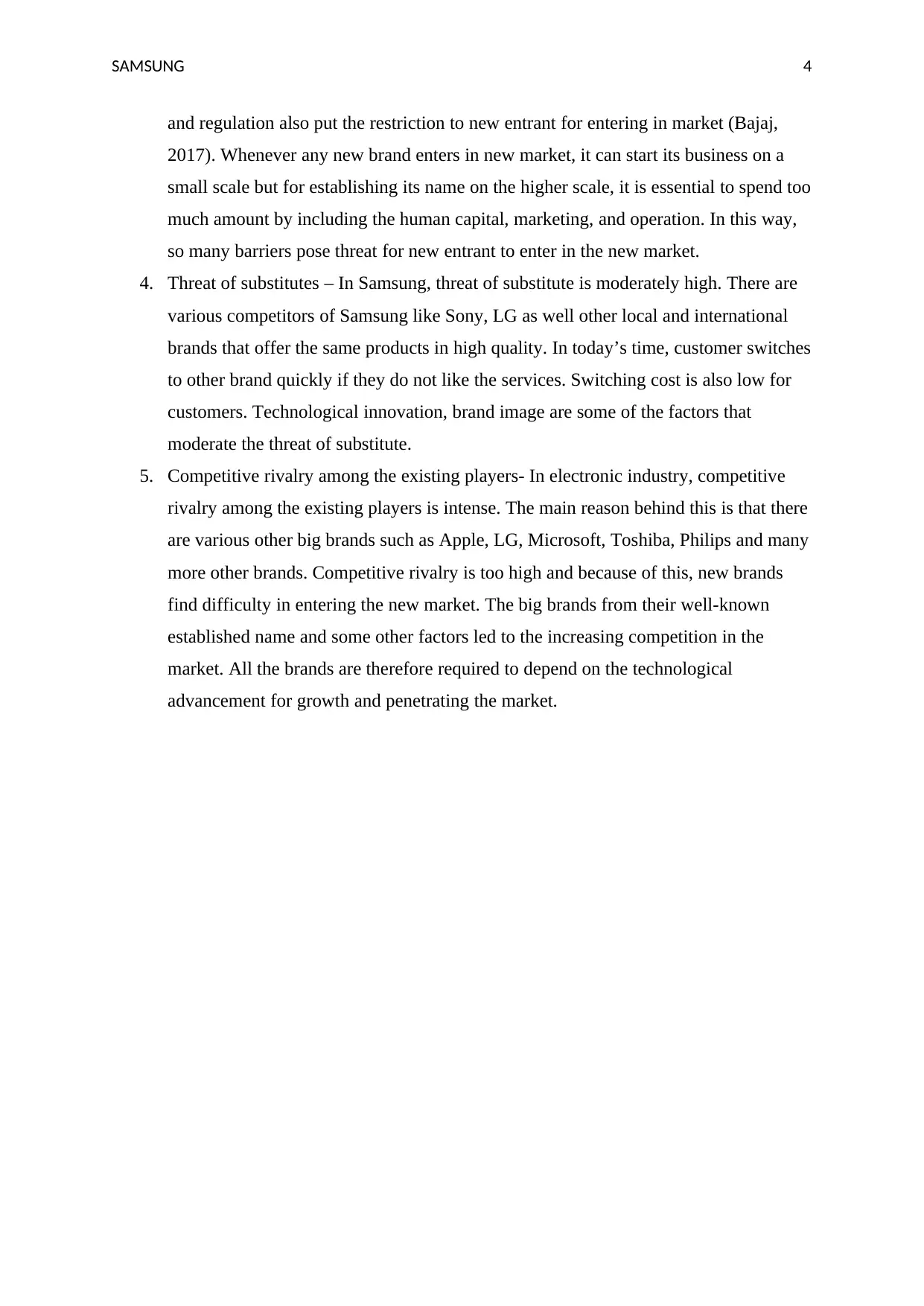
SAMSUNG 4
and regulation also put the restriction to new entrant for entering in market (Bajaj,
2017). Whenever any new brand enters in new market, it can start its business on a
small scale but for establishing its name on the higher scale, it is essential to spend too
much amount by including the human capital, marketing, and operation. In this way,
so many barriers pose threat for new entrant to enter in the new market.
4. Threat of substitutes – In Samsung, threat of substitute is moderately high. There are
various competitors of Samsung like Sony, LG as well other local and international
brands that offer the same products in high quality. In today’s time, customer switches
to other brand quickly if they do not like the services. Switching cost is also low for
customers. Technological innovation, brand image are some of the factors that
moderate the threat of substitute.
5. Competitive rivalry among the existing players- In electronic industry, competitive
rivalry among the existing players is intense. The main reason behind this is that there
are various other big brands such as Apple, LG, Microsoft, Toshiba, Philips and many
more other brands. Competitive rivalry is too high and because of this, new brands
find difficulty in entering the new market. The big brands from their well-known
established name and some other factors led to the increasing competition in the
market. All the brands are therefore required to depend on the technological
advancement for growth and penetrating the market.
and regulation also put the restriction to new entrant for entering in market (Bajaj,
2017). Whenever any new brand enters in new market, it can start its business on a
small scale but for establishing its name on the higher scale, it is essential to spend too
much amount by including the human capital, marketing, and operation. In this way,
so many barriers pose threat for new entrant to enter in the new market.
4. Threat of substitutes – In Samsung, threat of substitute is moderately high. There are
various competitors of Samsung like Sony, LG as well other local and international
brands that offer the same products in high quality. In today’s time, customer switches
to other brand quickly if they do not like the services. Switching cost is also low for
customers. Technological innovation, brand image are some of the factors that
moderate the threat of substitute.
5. Competitive rivalry among the existing players- In electronic industry, competitive
rivalry among the existing players is intense. The main reason behind this is that there
are various other big brands such as Apple, LG, Microsoft, Toshiba, Philips and many
more other brands. Competitive rivalry is too high and because of this, new brands
find difficulty in entering the new market. The big brands from their well-known
established name and some other factors led to the increasing competition in the
market. All the brands are therefore required to depend on the technological
advancement for growth and penetrating the market.
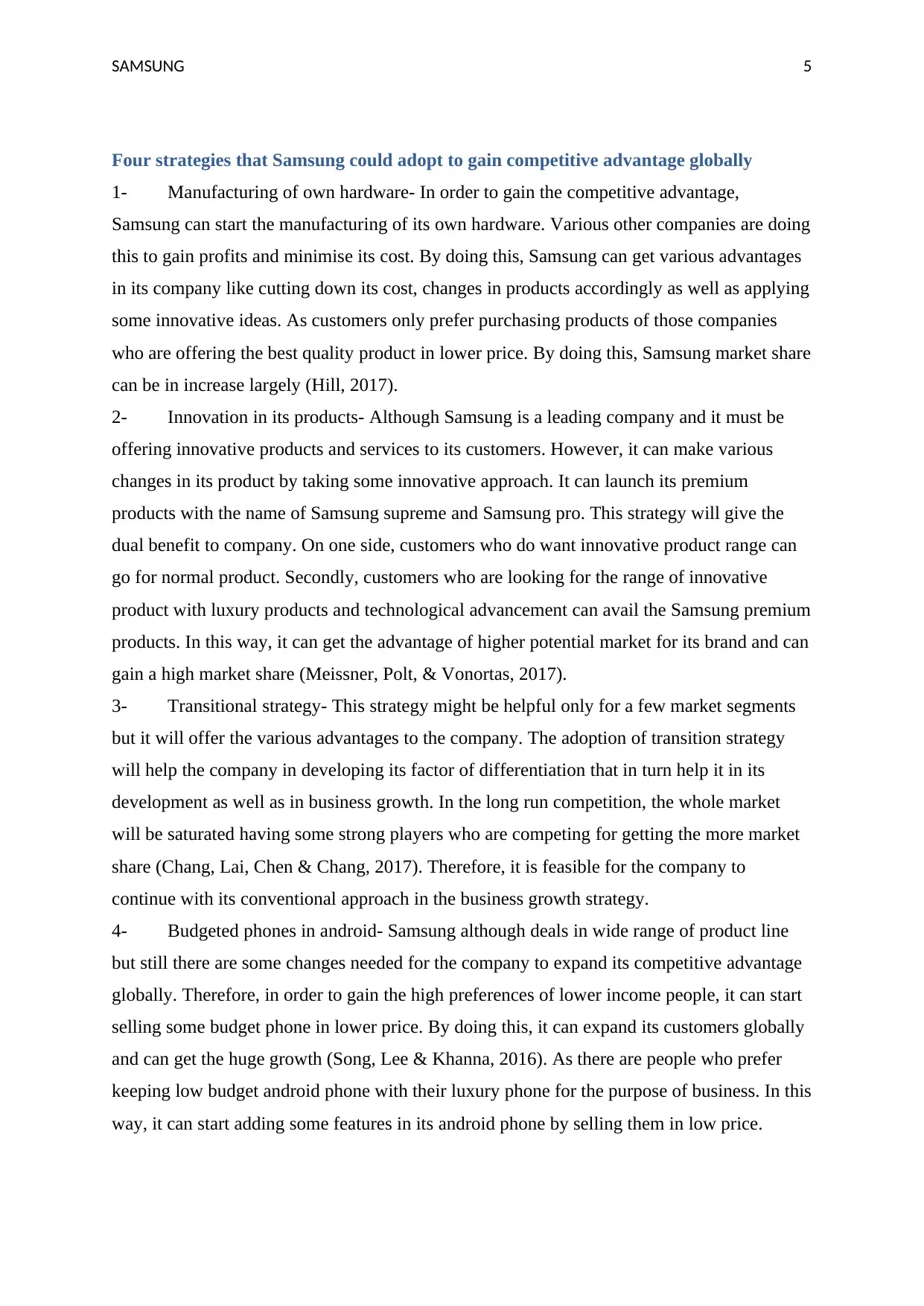
SAMSUNG 5
Four strategies that Samsung could adopt to gain competitive advantage globally
1- Manufacturing of own hardware- In order to gain the competitive advantage,
Samsung can start the manufacturing of its own hardware. Various other companies are doing
this to gain profits and minimise its cost. By doing this, Samsung can get various advantages
in its company like cutting down its cost, changes in products accordingly as well as applying
some innovative ideas. As customers only prefer purchasing products of those companies
who are offering the best quality product in lower price. By doing this, Samsung market share
can be in increase largely (Hill, 2017).
2- Innovation in its products- Although Samsung is a leading company and it must be
offering innovative products and services to its customers. However, it can make various
changes in its product by taking some innovative approach. It can launch its premium
products with the name of Samsung supreme and Samsung pro. This strategy will give the
dual benefit to company. On one side, customers who do want innovative product range can
go for normal product. Secondly, customers who are looking for the range of innovative
product with luxury products and technological advancement can avail the Samsung premium
products. In this way, it can get the advantage of higher potential market for its brand and can
gain a high market share (Meissner, Polt, & Vonortas, 2017).
3- Transitional strategy- This strategy might be helpful only for a few market segments
but it will offer the various advantages to the company. The adoption of transition strategy
will help the company in developing its factor of differentiation that in turn help it in its
development as well as in business growth. In the long run competition, the whole market
will be saturated having some strong players who are competing for getting the more market
share (Chang, Lai, Chen & Chang, 2017). Therefore, it is feasible for the company to
continue with its conventional approach in the business growth strategy.
4- Budgeted phones in android- Samsung although deals in wide range of product line
but still there are some changes needed for the company to expand its competitive advantage
globally. Therefore, in order to gain the high preferences of lower income people, it can start
selling some budget phone in lower price. By doing this, it can expand its customers globally
and can get the huge growth (Song, Lee & Khanna, 2016). As there are people who prefer
keeping low budget android phone with their luxury phone for the purpose of business. In this
way, it can start adding some features in its android phone by selling them in low price.
Four strategies that Samsung could adopt to gain competitive advantage globally
1- Manufacturing of own hardware- In order to gain the competitive advantage,
Samsung can start the manufacturing of its own hardware. Various other companies are doing
this to gain profits and minimise its cost. By doing this, Samsung can get various advantages
in its company like cutting down its cost, changes in products accordingly as well as applying
some innovative ideas. As customers only prefer purchasing products of those companies
who are offering the best quality product in lower price. By doing this, Samsung market share
can be in increase largely (Hill, 2017).
2- Innovation in its products- Although Samsung is a leading company and it must be
offering innovative products and services to its customers. However, it can make various
changes in its product by taking some innovative approach. It can launch its premium
products with the name of Samsung supreme and Samsung pro. This strategy will give the
dual benefit to company. On one side, customers who do want innovative product range can
go for normal product. Secondly, customers who are looking for the range of innovative
product with luxury products and technological advancement can avail the Samsung premium
products. In this way, it can get the advantage of higher potential market for its brand and can
gain a high market share (Meissner, Polt, & Vonortas, 2017).
3- Transitional strategy- This strategy might be helpful only for a few market segments
but it will offer the various advantages to the company. The adoption of transition strategy
will help the company in developing its factor of differentiation that in turn help it in its
development as well as in business growth. In the long run competition, the whole market
will be saturated having some strong players who are competing for getting the more market
share (Chang, Lai, Chen & Chang, 2017). Therefore, it is feasible for the company to
continue with its conventional approach in the business growth strategy.
4- Budgeted phones in android- Samsung although deals in wide range of product line
but still there are some changes needed for the company to expand its competitive advantage
globally. Therefore, in order to gain the high preferences of lower income people, it can start
selling some budget phone in lower price. By doing this, it can expand its customers globally
and can get the huge growth (Song, Lee & Khanna, 2016). As there are people who prefer
keeping low budget android phone with their luxury phone for the purpose of business. In this
way, it can start adding some features in its android phone by selling them in low price.
⊘ This is a preview!⊘
Do you want full access?
Subscribe today to unlock all pages.

Trusted by 1+ million students worldwide

SAMSUNG 6
Paraphrase This Document
Need a fresh take? Get an instant paraphrase of this document with our AI Paraphraser
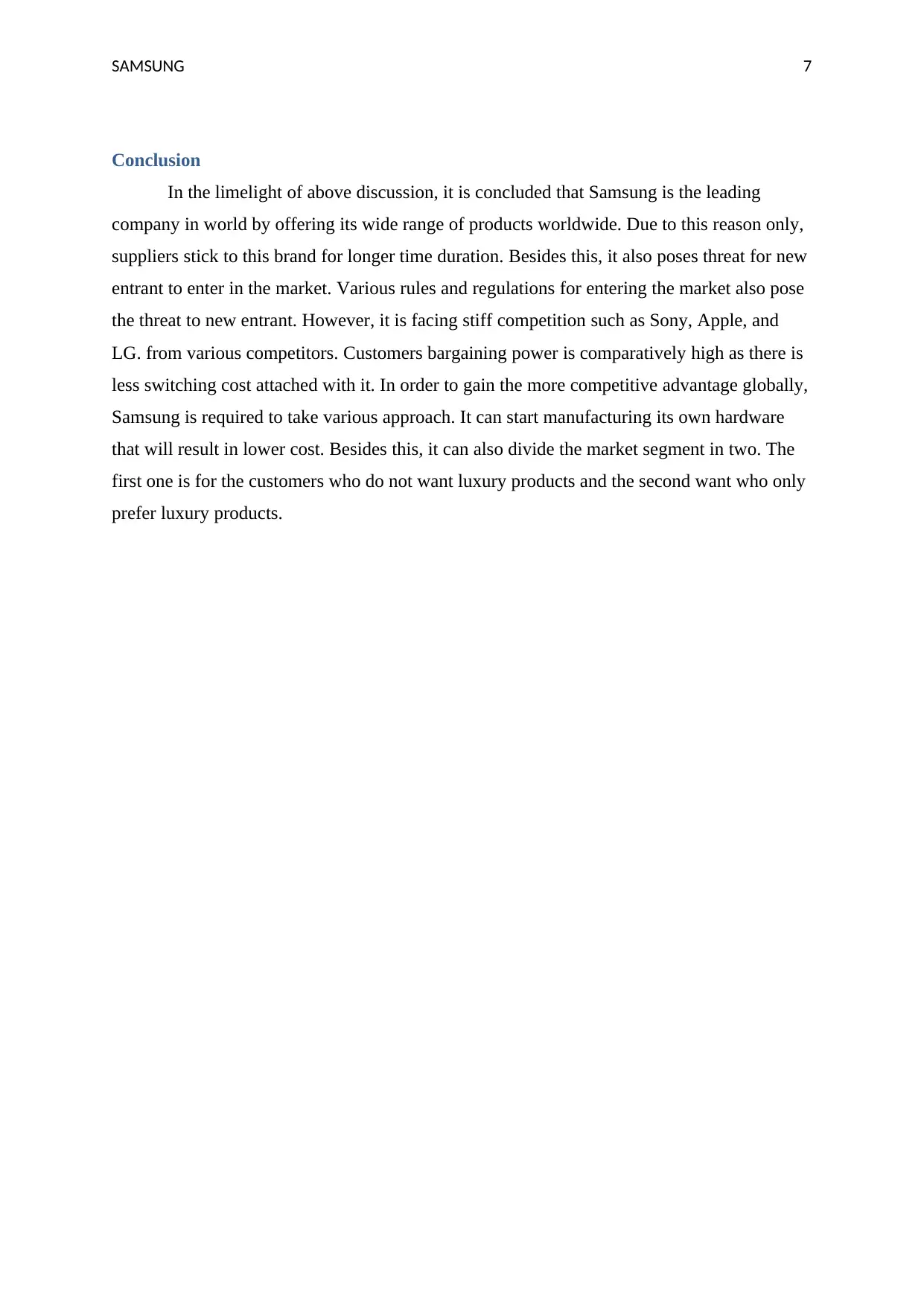
SAMSUNG 7
Conclusion
In the limelight of above discussion, it is concluded that Samsung is the leading
company in world by offering its wide range of products worldwide. Due to this reason only,
suppliers stick to this brand for longer time duration. Besides this, it also poses threat for new
entrant to enter in the market. Various rules and regulations for entering the market also pose
the threat to new entrant. However, it is facing stiff competition such as Sony, Apple, and
LG. from various competitors. Customers bargaining power is comparatively high as there is
less switching cost attached with it. In order to gain the more competitive advantage globally,
Samsung is required to take various approach. It can start manufacturing its own hardware
that will result in lower cost. Besides this, it can also divide the market segment in two. The
first one is for the customers who do not want luxury products and the second want who only
prefer luxury products.
Conclusion
In the limelight of above discussion, it is concluded that Samsung is the leading
company in world by offering its wide range of products worldwide. Due to this reason only,
suppliers stick to this brand for longer time duration. Besides this, it also poses threat for new
entrant to enter in the market. Various rules and regulations for entering the market also pose
the threat to new entrant. However, it is facing stiff competition such as Sony, Apple, and
LG. from various competitors. Customers bargaining power is comparatively high as there is
less switching cost attached with it. In order to gain the more competitive advantage globally,
Samsung is required to take various approach. It can start manufacturing its own hardware
that will result in lower cost. Besides this, it can also divide the market segment in two. The
first one is for the customers who do not want luxury products and the second want who only
prefer luxury products.
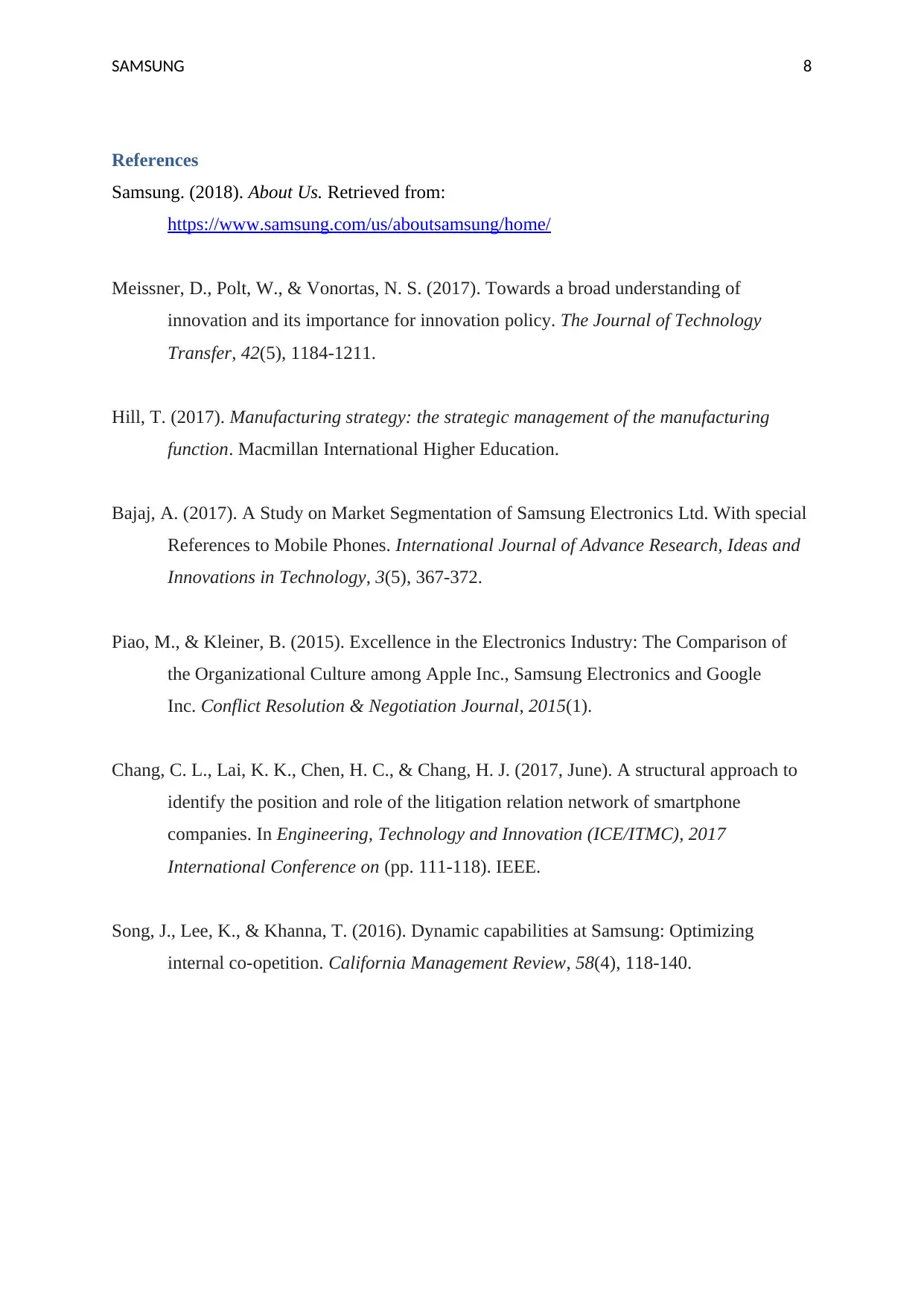
SAMSUNG 8
References
Samsung. (2018). About Us. Retrieved from:
https://www.samsung.com/us/aboutsamsung/home/
Meissner, D., Polt, W., & Vonortas, N. S. (2017). Towards a broad understanding of
innovation and its importance for innovation policy. The Journal of Technology
Transfer, 42(5), 1184-1211.
Hill, T. (2017). Manufacturing strategy: the strategic management of the manufacturing
function. Macmillan International Higher Education.
Bajaj, A. (2017). A Study on Market Segmentation of Samsung Electronics Ltd. With special
References to Mobile Phones. International Journal of Advance Research, Ideas and
Innovations in Technology, 3(5), 367-372.
Piao, M., & Kleiner, B. (2015). Excellence in the Electronics Industry: The Comparison of
the Organizational Culture among Apple Inc., Samsung Electronics and Google
Inc. Conflict Resolution & Negotiation Journal, 2015(1).
Chang, C. L., Lai, K. K., Chen, H. C., & Chang, H. J. (2017, June). A structural approach to
identify the position and role of the litigation relation network of smartphone
companies. In Engineering, Technology and Innovation (ICE/ITMC), 2017
International Conference on (pp. 111-118). IEEE.
Song, J., Lee, K., & Khanna, T. (2016). Dynamic capabilities at Samsung: Optimizing
internal co-opetition. California Management Review, 58(4), 118-140.
References
Samsung. (2018). About Us. Retrieved from:
https://www.samsung.com/us/aboutsamsung/home/
Meissner, D., Polt, W., & Vonortas, N. S. (2017). Towards a broad understanding of
innovation and its importance for innovation policy. The Journal of Technology
Transfer, 42(5), 1184-1211.
Hill, T. (2017). Manufacturing strategy: the strategic management of the manufacturing
function. Macmillan International Higher Education.
Bajaj, A. (2017). A Study on Market Segmentation of Samsung Electronics Ltd. With special
References to Mobile Phones. International Journal of Advance Research, Ideas and
Innovations in Technology, 3(5), 367-372.
Piao, M., & Kleiner, B. (2015). Excellence in the Electronics Industry: The Comparison of
the Organizational Culture among Apple Inc., Samsung Electronics and Google
Inc. Conflict Resolution & Negotiation Journal, 2015(1).
Chang, C. L., Lai, K. K., Chen, H. C., & Chang, H. J. (2017, June). A structural approach to
identify the position and role of the litigation relation network of smartphone
companies. In Engineering, Technology and Innovation (ICE/ITMC), 2017
International Conference on (pp. 111-118). IEEE.
Song, J., Lee, K., & Khanna, T. (2016). Dynamic capabilities at Samsung: Optimizing
internal co-opetition. California Management Review, 58(4), 118-140.
⊘ This is a preview!⊘
Do you want full access?
Subscribe today to unlock all pages.

Trusted by 1+ million students worldwide
1 out of 9
Related Documents
Your All-in-One AI-Powered Toolkit for Academic Success.
+13062052269
info@desklib.com
Available 24*7 on WhatsApp / Email
![[object Object]](/_next/static/media/star-bottom.7253800d.svg)
Unlock your academic potential
Copyright © 2020–2025 A2Z Services. All Rights Reserved. Developed and managed by ZUCOL.




